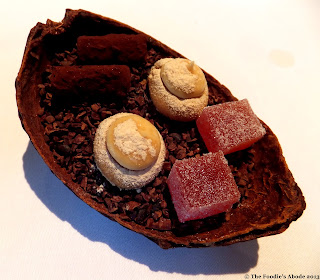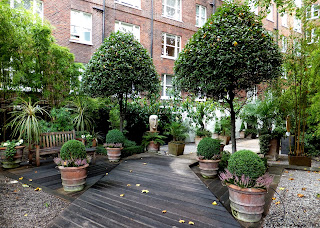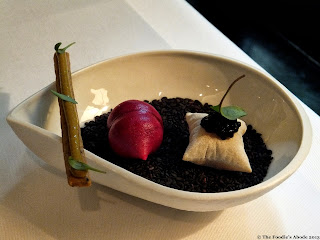Back home in a couple of days, and I thought I'd pay my favourite restaurant in London one last visit before leaving. I also brought a friend along for his first visit.
Canapé: poppy seed tartlet with Gruyère cream & shavings and finger lime. Lovely, as always.
Amuse bouche: ceviche of hand-dived scallops with Tokyo turnips, seaweed oil, frozen horseradish and apple jelly.
Lovely touch of generosity, as always. For regulars to the restaurant, you will know that this is a full dish in its own right, as well as a signature item. For more detailed comments, please refer to this recent review from June.
Starter 1: poached ceps with 2 year old Comté, Wiltshire truffle shavings & cream, dried black cabbage, and a broth of grilled onions with a dash of truffle & hazelnut oil.
My choice; this dish was very similar to another signature item, the Hampshire buffalo milk curd with mushrooms and onion broth. Most significantly, the buffalo curd had been replaced by a layer of molten cheese, and the strong and slightly sweet flavour of this wonderfully aged cow's milk cheese was the perfect complement to the intense and earthy ceps. The ceps' succulent texture was extremely satisfying when paired with the smooth and creamy cheese. The black cabbage (a kind of kale) also stood out in this dish, imparting a delicate sweet taste and crispy texture. The other accompaniments could of course have been taken for granted by me by now, but I should state that they were no less effective than they were in the original signature dish.
Starter 2: Crapaudine beetroot baked in clay, with smoked eel and dried black olives.
My friend's rather unusual choice turned out to be a very good one indeed! Just when I thought what miracles could possibly be worked with the humble beetroot, here came this masterpiece of flavour and plating. This, of course, was no ordinary beetroot; the Crapaudine variety from France is the oldest in cultivation, dating back to the time of Charlemagne. Stealing a few bites, I found its dark red flesh incredibly juicy, and baking in clay had resulted in a lovely firm texture as well as concentrated all of the beet's sweet earthy goodness; I couldn't have imagined a more flavourful beet. The crisp tuiles added another unexpected textural dimension. This astonishing vegetable was very aptly and proportionately paired with savoury touches such as a sprinkling of crushed & dried black olives, and dollops of smoked eel mousse. I did wonder, in hindsight, why there were no actual pieces of smoked eel, as most other pictures of this dish seemed to show them - had we been shortchanged?! Whatever the case, this was a thoroughly enjoyable dish which truly allowed high-quality produce to speak for itself, with minimal intervention.
Main course 1: roasted neck of lamb with fresh figs, baked root vegetables, fennel and dried black olives.
I had remembered the excellent lamb dish from my visit last month; both the neck and loin had been featured, but it was the former that I couldn't get enough of, with its melt-in-the-mouth texture and deep flavour. Now I had a much bigger chunk of neck alone to enjoy! On top of that, the accompaniments included my favourite figs, which complemented the luxurious meat perfectly with their creamy texture and sweetness. I really didn't want this to end!
Main course 2: aged fillet and short rib of Ruby Red beef from Devon with bone marrow, celeriac baked in ash and enrobed in juniper cream and dried black olives, crisp potato galette, wild garlic and spinach purée, celeriac purée, toppings of wild garlic, bone marrow and celeriac chips, sorrel garnish. (£10 supplement)
This was the highlight of the lunch for my friend. He had wanted to go for a fish or seafood dish but I persuaded him to take this, remembering the excellent beef dish I had had as part of the tasting menu in February. It was indeed worth every penny of the supplement charged; both parts of the beef were of course as tender, succulent and tasty as they could get, while the small blob of bone marrow contributed a truly decadent touch of creaminess and muskiness. What really surprised both of us, though, was the celeriac baked in ash; its sweetness, coupled with a surprisingly smooth and rich texture, was extremely satisfying. The layer of ash coating imparted a pleasant hint of bitterness, while the juniper emulsion, made with a mixture of soft boiled eggs, truffle juice and sherry vinegar, contributed a lovely complex flavour that was nothing like I've ever tasted. This humble root vegetable had been transformed beyond recognition! Wild garlic in this dish was another first for me; I was expecting something strong and pungent, but as a relative of the chive family it was actually rather mild and sweet. On the whole, this was an absolute masterpiece.
Dessert 1: fig leaf ice cream and crushed figs, with vanilla and fig coulis, meringue pieces, finger lime garnish and a drizzle of olive oil. Served with a side of lime beignets.
We were nearly at the end of the black fig season so I considered myself very lucky to be able to taste this excellent fruit again. The figs came this time crushed and shaped in the form of a terrine, and their rich texture and intense sweetness were very comforting indeed. Most unusually, the fig leaves were also used to make an ice cream, which tasted uncannily similar to coconut, with an mild aftertaste of warm spices. Very memorable first experience with this part of the fig! (A brief online search revealed that fig leaves are very good for you, being loaded with antioxidants; it is also often made into tea as a supplement for the control of diabetes.) A touch of vanilla cream was the perfect complement to this warm coconut-y taste, while the olive oil provided an essential touch of freshness together with the crisp and fluffy citrus beignets on the side. On the whole, this dessert was extremely sophisticated and well-balanced.
Dessert 2: brown sugar tart with stem ginger ice cream, Muscat grapes and a touch of balsamico.
Hardly my first encounter with this signature item of course, and I recommended that my friend try this for a first visit; needless to say he was also very impressed with the tart's richness and similarity in taste to gula melaka, and how the stem ginger ice cream balanced it with a pleasant spiciness. I certainly believe that this is one dessert that would appeal to all Southeast Asian people!
Complimentary dessert: banana and chocolate malt tartlet.
This was new to both of us, and although I had thought of ordering it on a previous visit, I hadn't gone ahead then, as I wasn't sure that a banana and chocolate combination would throw up any surprises. There's probably a reason why most fine restaurants shy away from bananas in their desserts, since they might feel compelled to display a certain level of sophistication and technique. But since this dessert was on the house now, perfect! No reason to complain, and I was sure it was going to be good anyway.
As expected, compared to the two previous desserts, this was relatively 'safe'. No earth-shattering endeavours here; this was indulgence pure and simple, given a slightly more classy presentation in line with fine dining standards. A tart pastry case contained a viscous banana purée with tiny banana chunks, smothered by a generous layer of rich gooey chocolate. Some textural definition was imparted by toppings of a crisp chocolate caramel tuile and chopped hazelnuts, and a sprinkling of chocolate malt soil on the side.
Petit fours to end the meal: blood orange jelly, juniper biscuit with caramel cream, and chocolate ganache with eucalyptus filling.
The only pity in this afternoon's lunch was that Laurens had gone back to the Netherlands on holiday and was not around to take care of us (though needless to say the service was still excellent). This meal was a truly fitting conclusion to my gastronomic experiences in London and other European cities. I consider myself extremely fortunate to have been able to eat at so many lovely places over the past two years, and look forward to a new chapter of foodie adventures back in Singapore and around Asia!
(Update 28/04/2014: The Ledbury is now no. 10 on the St. Pellegrino's list, up 3 places from last year - congratulations on a well-deserved upgrade!)

















































